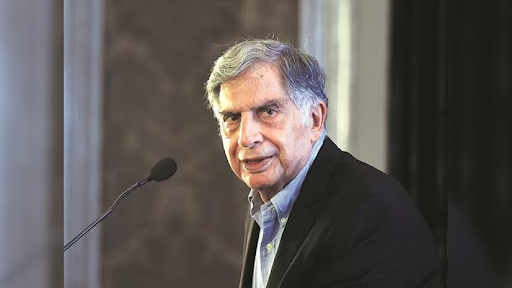Early Life and Education
• Born: December 28, 1937, in Bombay (now Mumbai), India.
• Family Background: Ratan Tata was born into a prominent Parsi family. He is the great-grandson of Jamsetji Tata, the founder of the Tata Group, one of India’s largest industrial empires. His father, Naval Tata, was adopted by Sir Ratanji Tata, one of the sons of Jamsetji Tata.
• Parents: Ratan’s parents, Naval Tata and Sooni Tata, separated when he was 10 years old. He and his younger brother, Jimmy, were raised by their grandmother, Lady Navajbai Tata.
• Education: Ratan Tata studied at the Campion School in Mumbai before attending the Bishop Cotton School in Shimla. He then completed his higher education at Cathedral and John Connon School in Mumbai and graduated from Cornell University, USA, with a degree in architecture in 1962. Later, he attended the Harvard Business School Advanced Management Program, completing it in 1975.
Early Career
• After completing his education, Ratan Tata briefly worked at Jones and Emmons, a Los Angeles-based architectural firm, before returning to India in 1962 to join the Tata Group.
• Initial Role at Tata: His first job at Tata was on the shop floor of Tata Steel in Jamshedpur, where he worked alongside laborers, shoveling limestone and handling the blast furnace. This hands-on experience was vital in shaping his understanding of the company’s core operations.
Rise to Leadership
• Entry into Leadership: In 1971, he was appointed the Director-in-Charge of National Radio and Electronics Company Limited (Nelco), a struggling division of the Tata Group. Although he turned it around briefly, the company couldn’t sustain itself due to an economic downturn.
• Leadership of Tata Group: Ratan Tata became the Chairman of Tata Industries in 1981 and took over as the Chairman of Tata Sons, the holding company of the Tata Group, in 1991. He succeeded JRD Tata, under whose leadership the group had expanded considerably.
Transforming the Tata Group
• Global Expansion: Under Ratan Tata’s leadership, the Tata Group transformed from a largely India-focused company into a global conglomerate. Some of his most notable acquisitions include:
• Tetley Tea (2000): Tata Tea acquired the UK’s Tetley Tea, making it one of the largest tea companies in the world.
• Corus Steel (2007): Tata Steel acquired the European steel giant Corus Group for $12 billion, making Tata Steel the fifth-largest steel producer in the world at the time.
• Jaguar Land Rover (2008): Tata Motors acquired the luxury British car brands Jaguar and Land Rover from Ford for $2.3 billion, a move that was initially questioned but eventually turned highly profitable.
• Tata Consultancy Services (TCS): During his tenure, TCS became one of the leading global IT services firms, playing a crucial role in India’s IT boom.
• Tata Nano: One of Ratan Tata’s ambitious projects was the development of the Tata Nano, launched in 2009. It was designed to be the world’s cheapest car, aimed at making vehicle ownership accessible to millions of Indians. Though the car received significant attention, it ultimately faced commercial challenges.
Leadership Style and Legacy
• Visionary Leadership: Ratan Tata is often praised for his long-term vision and his ability to take bold decisions that positioned Tata as a global company. He focused on innovation and risk-taking, a stark contrast to the conservative approach followed by many Indian business houses.
• Ethical Leadership: Tata is also known for upholding the highest ethical standards in business. He avoided shortcuts and believed in contributing to society through responsible business practices.
Retirement
• Ratan Tata stepped down as chairman of Tata Sons in December 2012 at the age of 75, though he remained active in various capacities within the Tata Group and Tata Trusts. He was succeeded by Cyrus Mistry, who was later ousted in a highly publicized corporate battle in 2016.
• In 2016, Ratan Tata returned as interim chairman of Tata Sons for a short period until Natarajan Chandrasekaran was appointed chairman in 2017.
Philanthropy and Contributions
• Ratan Tata is deeply involved in philanthropy, primarily through the Tata Trusts, which control around 66% of Tata Sons’ equity. Under his leadership, Tata Trusts have funded various initiatives in health, education, and rural development.
• He personally donated significant amounts to causes like education and healthcare. He has also been instrumental in Tata’s commitment to corporate social responsibility.
Awards and Recognition
• Padma Bhushan (2000): The third-highest civilian award in India.
• Padma Vibhushan (2008): The second-highest civilian award in India.
• He has received honorary degrees from various prestigious institutions and numerous international awards recognizing his contributions to business and society.
Personal Life
• Ratan Tata has remained unmarried, often citing personal reasons for not marrying. He is known for his simplicity and humility, despite his immense success. He is an animal lover and is actively involved in various animal welfare causes.
Current Involvement
• Even after retirement, Ratan Tata remains an influential figure in Indian and global business circles. He is involved in investing in startups through RNT Associates and as an advisor to venture capital funds. He has invested in several startups, including Paytm, Ola, and Snapdeal.
Key Contributions and Legacy
• Ratan Tata is credited with transforming the Tata Group into a global powerhouse while maintaining the company’s commitment to ethical business practices.
• He is celebrated for his forward-thinking leadership, contributions to Indian industry, and the impact of his philanthropic efforts.
Ratan Tata’s life and career exemplify the blending of business acumen with a strong sense of ethics and responsibility toward society.

